An Evaluation of the Importance of Smart Tourism Tools in the Riobamba Canton, Ecuador
Abstract
:1. Introduction
2. Materials and Methods
2.1. Study Area
2.2. Survey
2.3. Analysis
3. Results
3.1. Sociodemographic Data
3.2. Importance of Smart Tourism Tools
3.3. Data Association and Similarity by the Correspondence Analysis
4. Discussion
5. Conclusions
Author Contributions
Funding
Institutional Review Board Statement
Informed Consent Statement
Data Availability Statement
Acknowledgments
Conflicts of Interest
Appendix A
| Smart Tourism Tools | Abbreviation Used in This Study |
| Destination homepage | DHP |
| Mobile application | MAP |
| Free Wi-Fi | FWF |
| Online information access | OIA |
| Quick response code | QRC |
| Electronic touchscreen | ETS |
| Short-messaging service and multi-media messaging service | MES |
| Call-service center | CCS |
| Intelligent-guide system | IGS |
| Personal itinerary design | PID |
| E-tourism recommendation system | ERS |
| Guiding information service | GIS |
| E-tour map | ETM |
| Smart card (band) | SCB |
| Electronic-entrance guard system | EGS |
| Smart environment | SEN |
| Tourist-flow monitoring | TFM |
| Crowd handling | CHD |
| Smart education | SED |
| E-complaint handling | ECH |
| Mobile payment | MPM |
| Electronic-ticketing system | ETK |
| Online coupons | OLC |
| Online booking | OLB |
| Tourist-flow forecast | TFF |
| Festival-activity forecast | FAF |
| Queuing-time forecast | QTF |
| Weather forecast | WFC |
| Electronic toll collection | ETC |
| Smart vehicle scheduling | SVS |
| Real-time traffic broadcast | RTB |
| Intelligent-environment monitoring | IEM |
| Traffic-safety protection | TSP |
| Smart emergency response system | SES |
| Virtual tourism experience | VTE |
| Virtual travel community | VTC |
| Augmented reality | ARE |
| Blogs of tourist attractions | BTA |
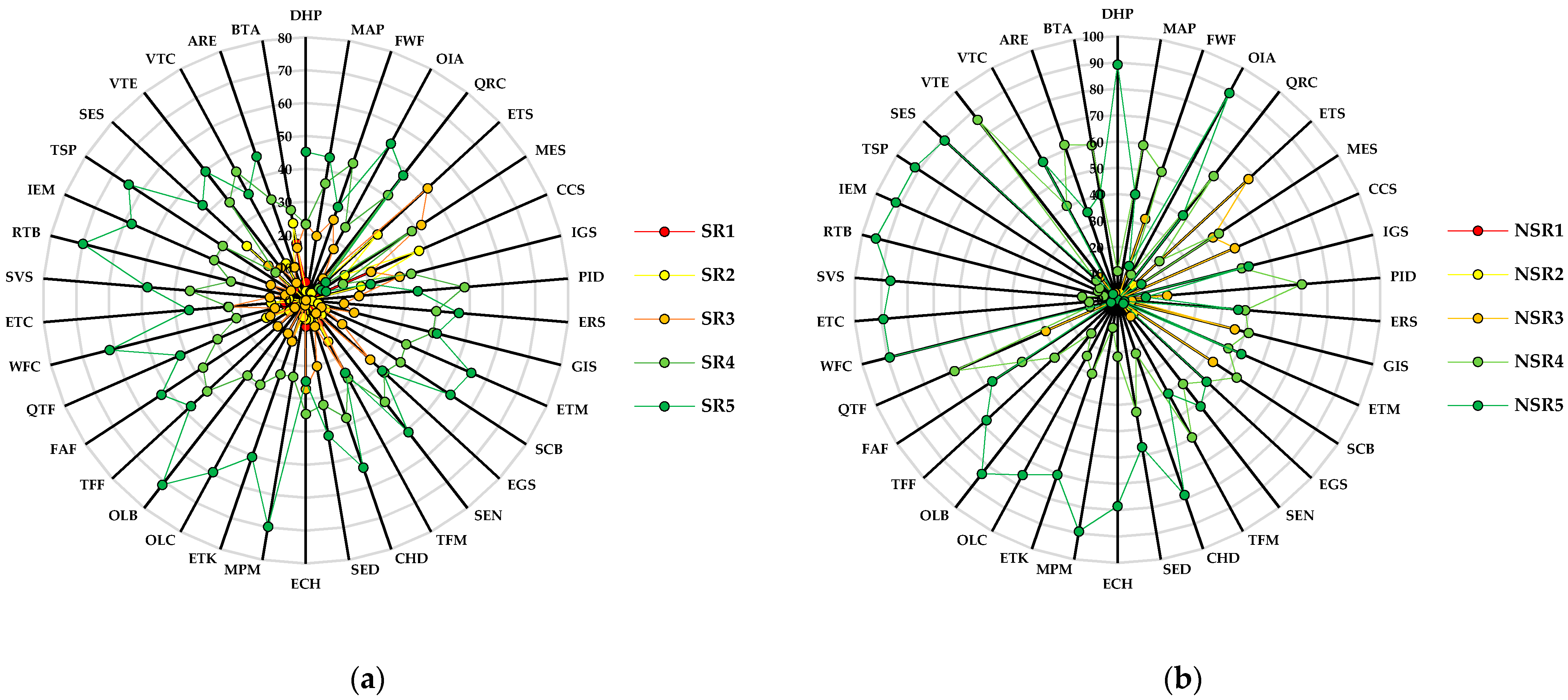
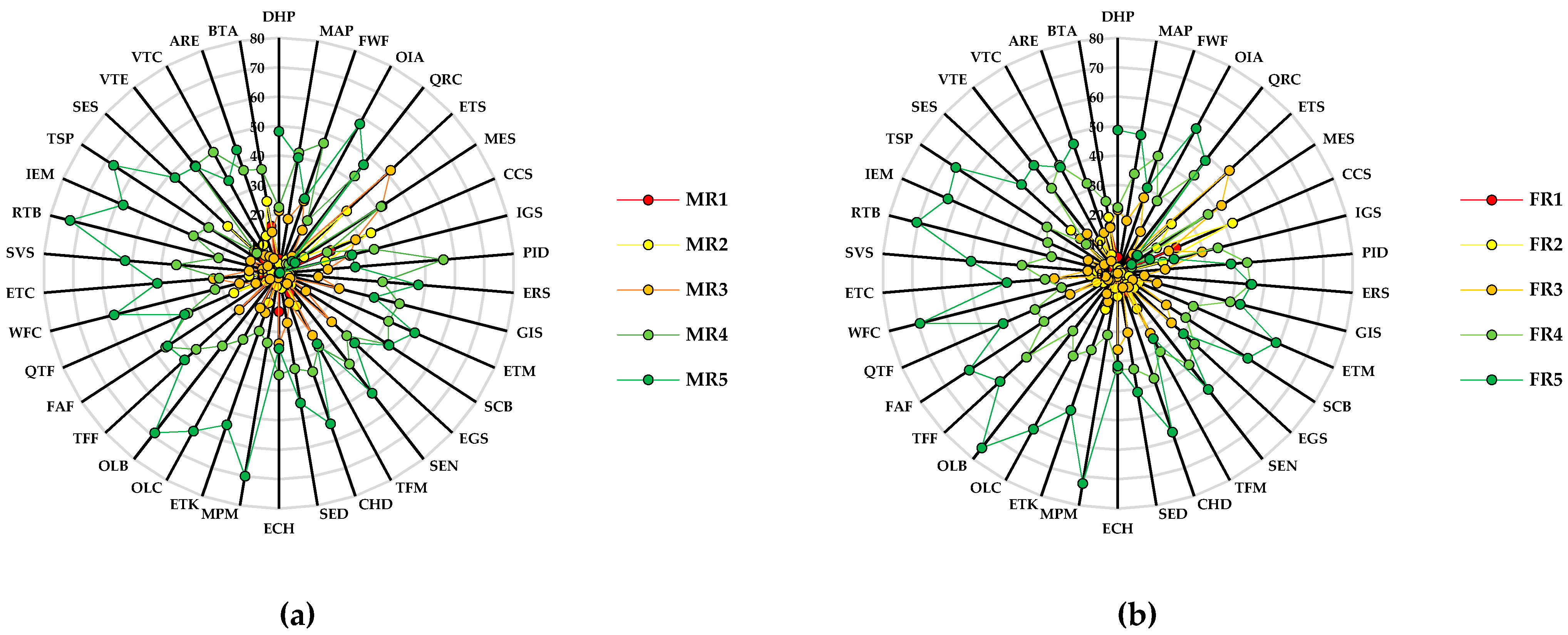
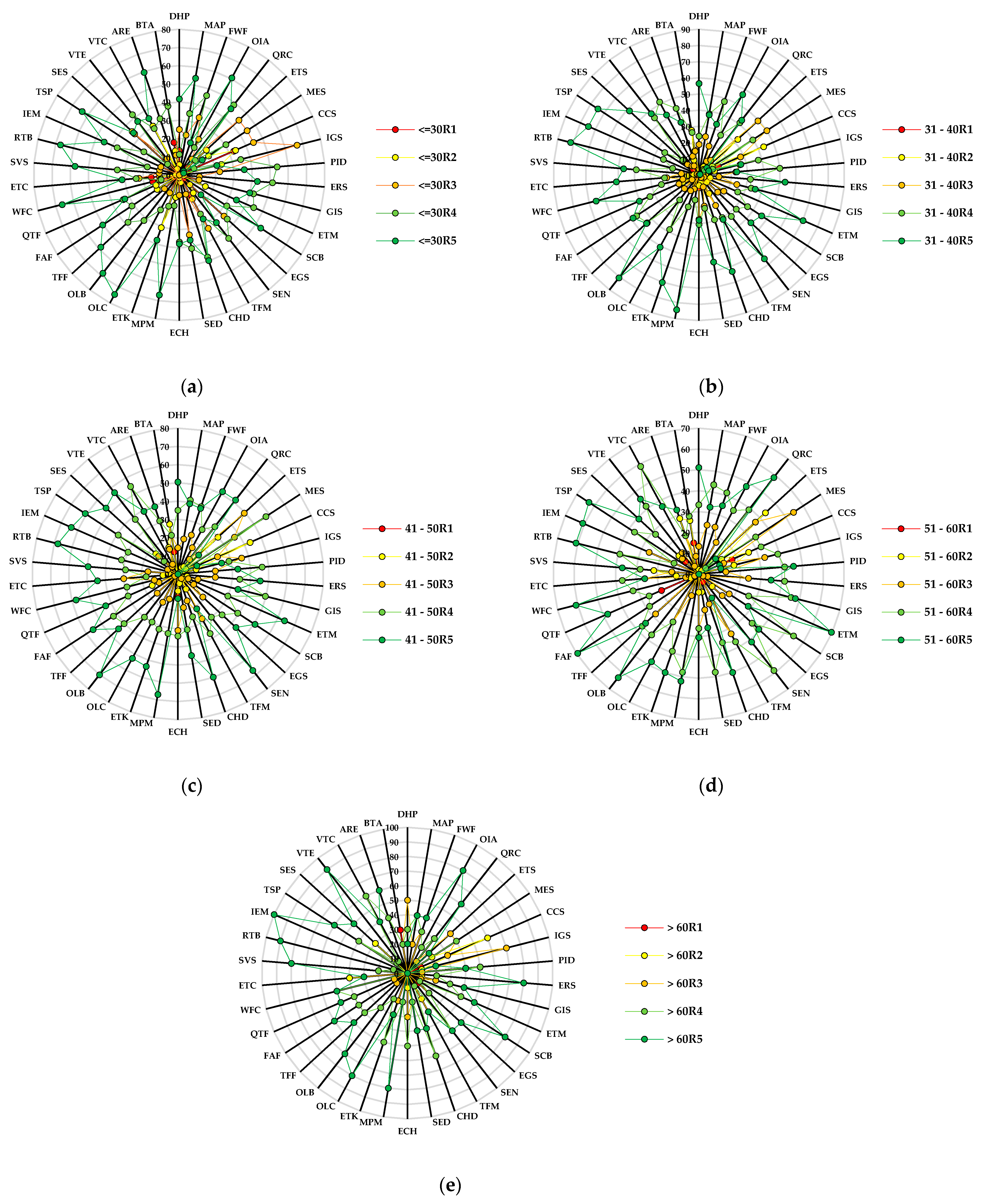
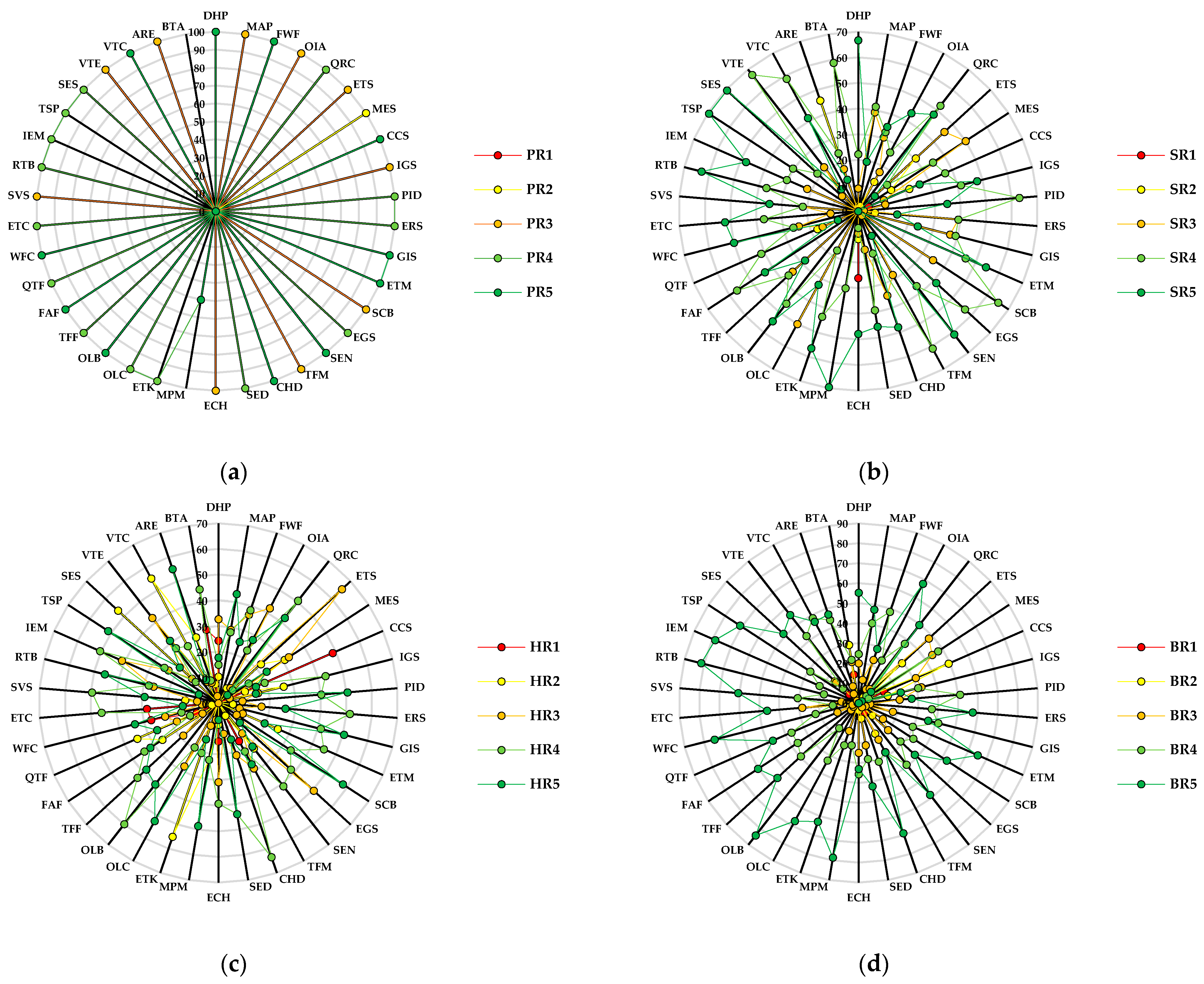
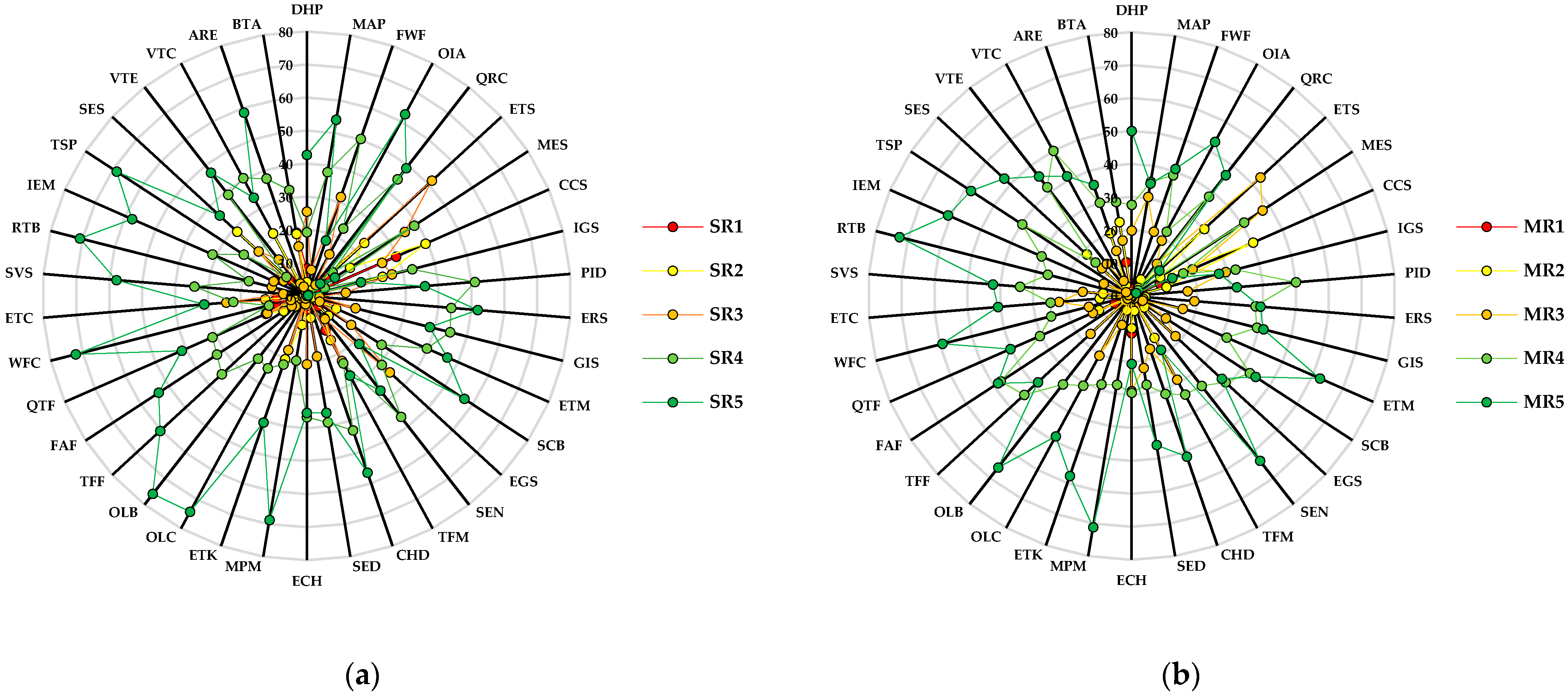
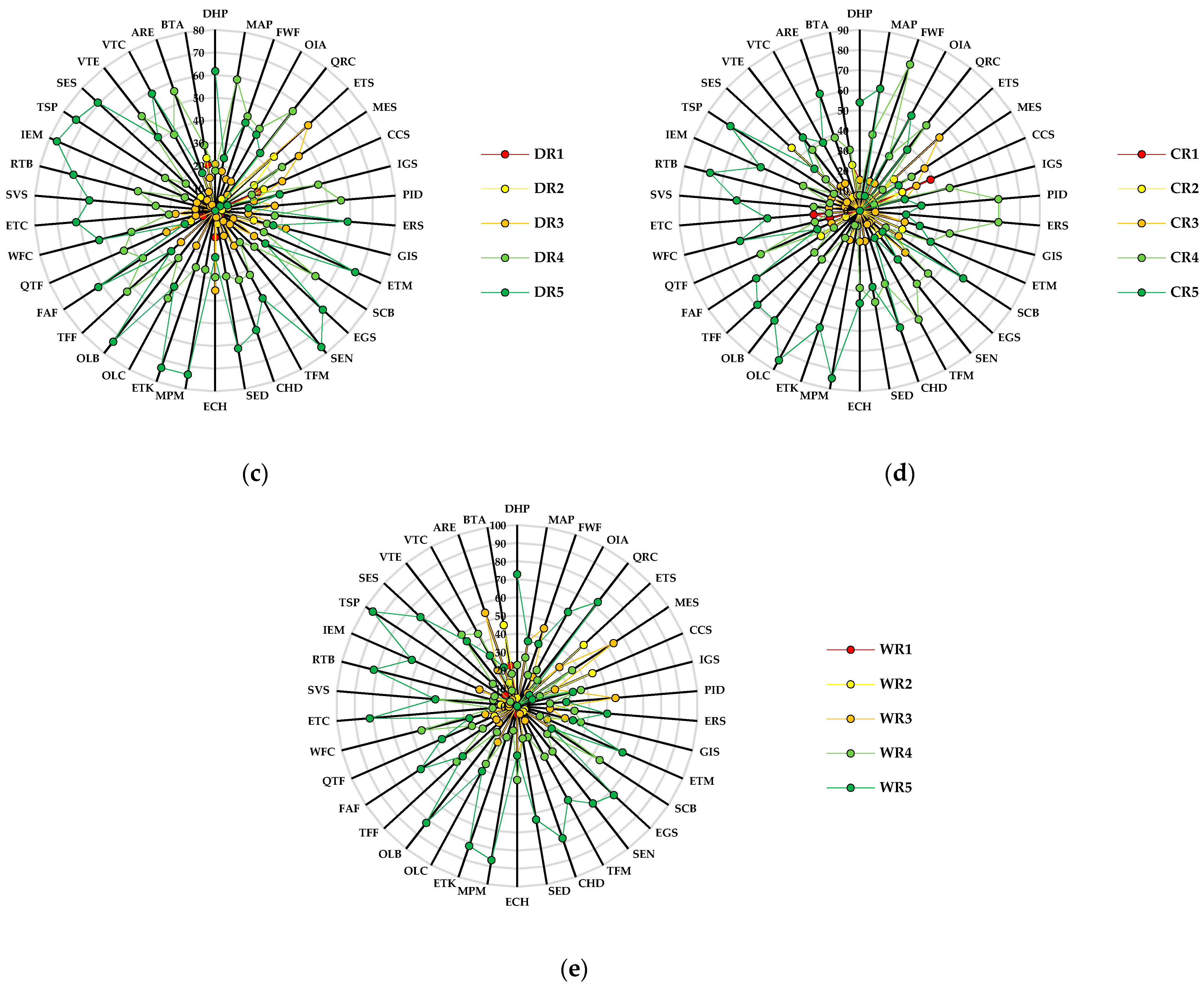


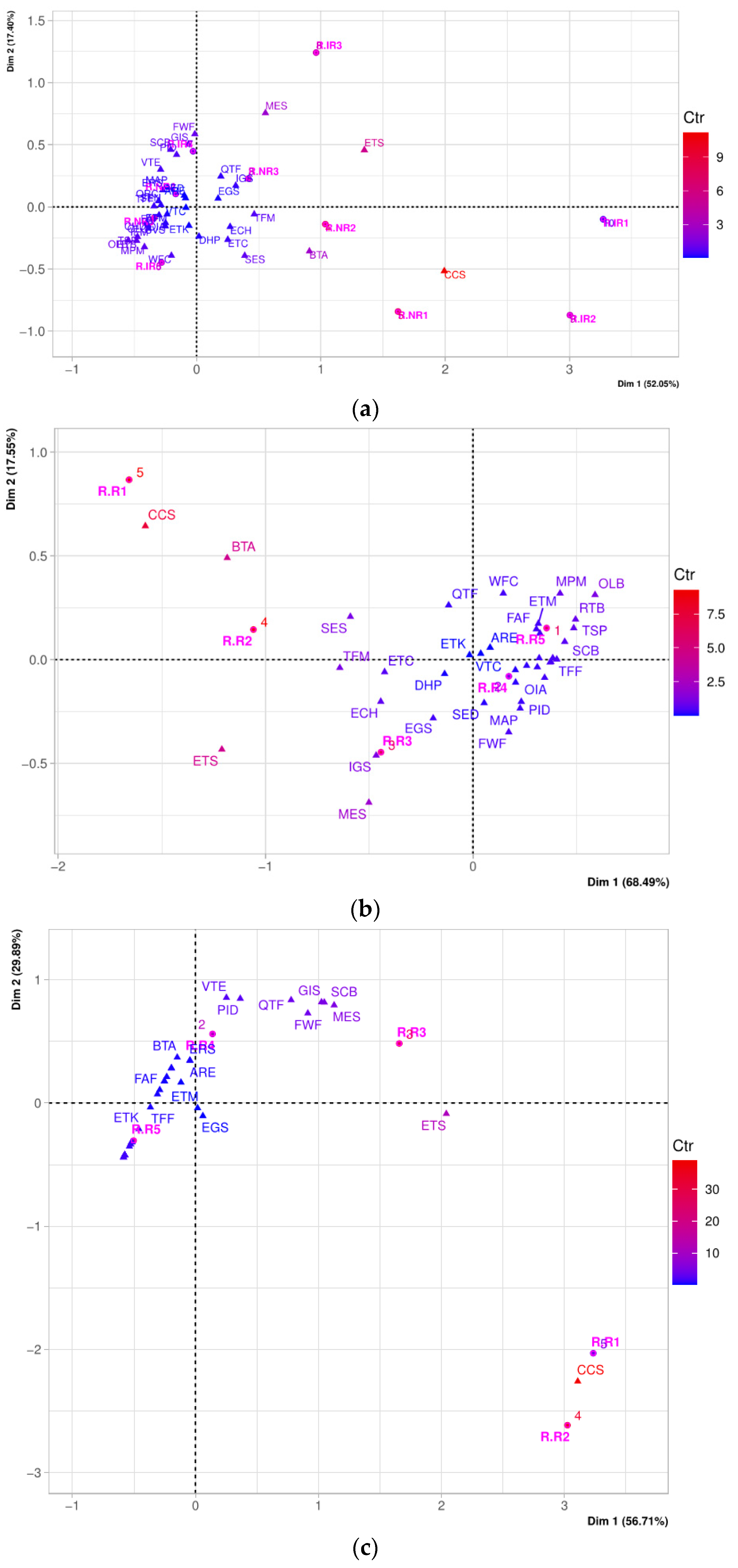
References
- Paladines, M.; Machado, O.; Proaño, P. Factores influyentes en la lealtad electrónica hacia comunidades turísticas en línea: Caso mochileros. Rev. Cienc. Soc. 2019, 25, 200–217. [Google Scholar] [CrossRef]
- Chinchay, S.; Córdova, J.; Tume, A.; Sanz, R.S.S. Estrategias de promoción para el fomento del turismo religioso en Perú. Rev. Cienc. Soc. 2020, 26, 272–283. [Google Scholar] [CrossRef]
- Steiger, R.; Scott, D.; Abegg, B.; Pons, M.; Aall, C. A critical review of climate change risk for ski tourism. Curr. Issues Tour. 2019, 22, 1343–1379. [Google Scholar] [CrossRef] [Green Version]
- Thommandru, A.; Espinoza, M.; Ramirez, E.; Ray, S.; Naved, M.; Guzman, M. Role of tourism and hospitality business in economic development. Mater. Today Proc. 2021. [Google Scholar] [CrossRef]
- Cobeña, M. Importancia del turismo para el desarrollo local de la provincia Manabí. Revista Electrónica Cooperación Universidad Sociedad 2018, 3, 44–49. [Google Scholar] [CrossRef]
- Bravo, L.; Macías, N.; Valdés, Z. Turismo comunitario en Ecuador: Apuntes en tiempos de pandemia. Revista de Ciencias Sociales (Ve) 2021, 27, 265–277. [Google Scholar] [CrossRef]
- World Tourism Organization. Definition of Sustainable Tourism Development; World Tourism Organization: Madrid, Spain, 2019; Volume 19, pp. 1–32. Available online: https://sdt.unwto.org/content/about-us-5 (accessed on 23 July 2021).
- Casado, L.; Sánchez, J.; Bastidas, A. Tourism Research after the COVID-19 Outbreak: Insights for More Sustainable, Local and Smart Cities. Sustain. Cities Soc. 2021, 103126. [Google Scholar] [CrossRef]
- Verma, P.; Raghubanshi, A. Urban sustainability indicators: Challenges and opportunities. Ecol. Indic. 2018, 93, 282–291. [Google Scholar] [CrossRef]
- Ocampo, L.; Ebisa, J.; Ombe, J.; Escoto, M. Sustainable ecotourism indicators with fuzzy Delphi method—A Philippine perspective. Ecol. Indic. 2018, 93, 874–888. [Google Scholar] [CrossRef]
- Kristjánsdóttir, K.; Ólafsdóttir, R.; Ragnarsdóttir, K. Reviewing integrated sustainability indicators for tourism. J. Sustain. Tour. 2018, 26, 583–599. [Google Scholar] [CrossRef]
- Lee, T.; Hsieh, H. Indicators of sustainable tourism: A case study from a Taiwan’s wetland. Ecol. Indic. 2016, 67, 779–787. [Google Scholar] [CrossRef]
- Chong, K.; Balasingam, A. Tourism sustainability: Economic benefits and strategies for preservation and conservation of heritage sitesin Southeast Asia. Tour. Rev. 2019, 74, 268–279. [Google Scholar] [CrossRef]
- Wang, J.; Wang, S.; Wang, Y.; Li, J.; Zhao, D. Extending the theory of planned behavior to understand consumers’ intentions to visit green hotels in the Chinese context. Int. J. Contemp. Hosp. Manag. 2018, 30, 2810–2825. [Google Scholar] [CrossRef]
- Porto, N.; Rucci, A.; Simon, D.; Garbero, N.; Almond, B. Critical elements in accessible tourism for destination competitiveness and comparison: Principal component analysis from Oceania and South America. Tour. Manag. 2019, 75, 169–185. [Google Scholar] [CrossRef]
- Manner, F.; Carvache, M.; Carvache, W. The Image of Ecuador in the Chinese Youth Market: Tourist Preferences and Motivations. J. China Tour. Res. 2020, 22, 1–16. [Google Scholar] [CrossRef]
- Mintur. 17. Ministerio de Turismo del Ecuador. Plan Nacional de Turismo 2030; Mintur: Havana, Cuba, 2019; Available online: https://www.turismo.gob.ec/wp-content/uploads/2020/03/PLAN-NACIONAL-DE-TURISMO-2030-v.-final-Registro-Oficial-sumillado-comprimido_compressed.pdf (accessed on 23 July 2021).
- Transport Ecuador. Boletines 2018. Available online: https://transport.ec/boletinesinstitucionales/ (accessed on 23 July 2021).
- Carrión, P.; Borja, C.; Herrera, G.; Morante, F.; Jaya, M.; Maldonado, A.; Berrezueta, E. Geo sitios y geoturismo en el desarrollo local de comunidades de la Cordillera de los Andes. Un caso de estudio. Sostenibilidad 2021, 13, 4624. [Google Scholar] [CrossRef]
- Gobierno Autónomo Descentralizado Municipal del cantón Riobamba. Plan De Desarro. Y Ordenamiento Territ. Del Cantón Riobamba. 2020. Available online: https://www.gadmriobamba.gob.ec/index.php/descarga/plan-pdyot-2020-2030?download=2496:pdot-tomo-ii-pdf (accessed on 23 July 2021).
- Ruiz, S.; Hernández, Y. Impacto de las TIC en el sector turístico y su importancia. Univ. Cienc. 2017, 6, 66–76. [Google Scholar]
- Femenia, F.; Neuhofer, B.; Ivars, J. Towards a conceptualisation of smart tourists and their role within the smart destination scenario. Serv. Ind. J. 2019, 39, 109–133. [Google Scholar] [CrossRef] [Green Version]
- Buhalis, D.; Law, R. Progress in information technology and tourism management: 20 years on and 10 years after the Internet—The state of eTourism research. Tour. Manag. 2008, 29, 609–623. [Google Scholar] [CrossRef] [Green Version]
- Benckendorff, P.; Sheldon, P.; Fesenmaier, D. The digital tourism landscape. In Tourism Information Technology, 2nd ed.; CABI: Wallingford, UK, 2014; pp. 22–52. [Google Scholar] [CrossRef]
- Luo, L.; Zhou, J. BlockTour: A blockchain-based smart tourism platform. Comput. Commun. 2021, 175, 186–192. [Google Scholar] [CrossRef]
- Gretzel, U.; Yuan, Y.; Fesenmaier, D. Preparing for the new economy: Advertising strategies and change in destination marketing organizations. J. Travel Res. 2000, 39, 146–156. [Google Scholar] [CrossRef]
- García, A.; Juaneda, E.; Olarte, C.; Pelegrín, J. Towards the smart tourism destination: Key factors in information source use on the tourist shopping journey. Tour. Manag. Perspect. 2020, 36, 100730. [Google Scholar] [CrossRef] [PubMed]
- Tussyadiah, I.; Wang, D. Tourists’ Attitudes toward Proactive Smartphone Systems. J. Travel Res. 2014, 55, 493–508. [Google Scholar] [CrossRef]
- Sigalat, E.; Calvo, R.; Roig, B.; García, I. Transition towards a tourist innovation model: The smart tourism destination: Reality or territorial marketing? J. Innov. Knowl. 2020, 5, 96–104. [Google Scholar] [CrossRef]
- Falco, E.; Kleinhans, R. Digital participatory platforms for co-production in urban development: A systematic review. In Crowdsourcing: Concepts, Methodologies, Tools, and Applications; 2019; IGI Global: Hershey, PA, USA, 2019; Volume 7, pp. 663–690. [Google Scholar] [CrossRef] [Green Version]
- Artmann, M.; Kohler, M.; Meinel, G.; Gan, J.; Ioja, I. How smart growth and green infrastructure can mutually support each other—A conceptual framework for compact and green cities. Ecol. Indic. 2017, 96, 10–22. [Google Scholar] [CrossRef]
- Zach, F.; Krizaj, D. Experiences Through Design and Innovation Along Touch Points. Tour. Verge. Springer Cham. 2017. [Google Scholar] [CrossRef]
- Gajdošík, T. Smart tourists as a profiling market segment: Implications for DMOs. Tour. Econ. 2019, 26, 1042–1062. [Google Scholar] [CrossRef]
- Wang, X.; Li, X.; Zhen, F.; Zhang, J. How smart is your tourist attraction: Measuring tourist preferences of smart tourism attractions via a FCEM-AHP and IPA approach. Tour. Manag. 2016, 54, 309–320. [Google Scholar] [CrossRef]
- Vega, E.; Jara, J. Estimación de la evapotranspiración de referencia para dos zonas (costa y región andina) del Ecuador. Eng. Agrícola 2009, 29, 390–403. [Google Scholar] [CrossRef]
- Gobierno Autónomo Descentralizado Municipal del cantón Riobamba. Plan de Desarrollo y Ordenamiento Territorial del cantón Riobamba. 2015. Available online: http://www.gadmriobamba.gob.ec/phocadownload/lotaip/AnexoS/PLAN%20DE%20DESARROLLO%20Y%20ORDENAMIENTO%20%20TERRITORIAL%20 CON%20RESOLUCIONES.pdf (accessed on 23 July 2021).
- Instituto Nacional de Estadística y Censos. INEC. Población y Parroquias Urbanas y Rurales. 2010. Available online: https://www.ecuadorencifras.gob.ec/wp-content/descargas/Manu-lateral/Resultados-provinciales/chimborazo.pdf (accessed on 23 July 2021).
- Calderón, D. Memorias andinas. Propuesta de Video Sobre el Trabajo Artesanal Realizado Por los Habitantes de la Comunidad 4 Esquinas, Para Promover el Desarrollo Económico y Cultural. Bachelor’s Thesis, Universidad de Palermo, Buenos Aires, Argentina, 2018. [Google Scholar]
- Pérez, N.; Mullo, H.; Marcatoma, J.; Promedio, P. Análisis del cambio climático en un ecosistema alto andino, riobamba-ecuador. Perfiles 2020, 23, 1–8. [Google Scholar]
- Vaca, P.; Vaca, M.; Vaca, M.; Colcha, D. Monitoreo de los sitios de visita de la Reserva de Producción de Fauna Chimborazo-Ecuador y su contribución al cumplimiento de los objetivos de conservación. Recus. Rev. Electrónica Coop. Univ. Soc. 2020, 5, 55–63. [Google Scholar] [CrossRef]
- Castillo, D.; Gavilanes, A.; Ricaurte, C.; Chávez, C.; Marcu, V.; Borz, S. Perception and use of cultural ecosystem services among the Andean communities of Chimborazo reserve. Environ. Eng. Manag. J. 2019, 18, 1–14. [Google Scholar] [CrossRef]
- Castillo, D.; Chávez, C.; Marcu, V.; Gavilanes, A. The use of cultural ecosystem services: A comparison between locals and tourists in the Chimborazo Natural Reserve. Bull. Transilv. Univ. Brasov. For. Wood Ind. Agric. Food Eng. Ser. II 2020, 13, 1–18. [Google Scholar] [CrossRef]
- Ministerio del Ambiente del Ecuador (MAE). Monthly and Annual Report of the Arrival of Tourists to the Protected Areas of Ecuador. 2017. Unique Environmental Information System. Available online: http://suia.ambiente.gob.ec/documents/10179/1232803/Reporte+Registro+Visitas+2%20017.pdf/9bd93aa7-8751-4272-ae99-73cdf4b23d75 (accessed on 23 July 2021).
- Doey, L.; Curta, J. Correspondence Analysis applied to psychological research. Tutor. Quant. Methods Psychol. 2011, 7, 5–14. [Google Scholar] [CrossRef]
- Bendixen, M. A practical guide to the use of correspondence analysis in marketing research. Marketing Bulletin 14. Technical Note 2. 2003. Available online: http://marketing-bulletin.massey.ac.nz (accessed on 23 July 2021).
- Bendixen, M. Compositional perceptual mapping using chi-squared trees analysis and correspondence analysis. J. Mark. Manag. 1995, 11, 571–581. [Google Scholar] [CrossRef]
- Gračan, D.; Zadel, Z.; Pavlović, D. Management of visitor satisfaction by using mobile digital tools and services to create concept of smart destination. Ekon. Pregl. 2021, 72, 185–198. [Google Scholar] [CrossRef]
- de Esteban, J.; Jalón, M.; Herráez, B.; Antonovica, A. Smart tourism destination in Madrid. Sustain. Smart Cities 2017, 101–114. [Google Scholar] [CrossRef]
- Brennan, B.; Koo, C.; Bae, K. Smart Tourism: A Study of Mobile Application Use by Tourists Visiting South Korea. Arts Humanit. Soc. Converg. Multimed. Papers 2018, 8, 1–9. [Google Scholar] [CrossRef]
- Xiang, Z.; Stienmetz, J.; Fesenmaier, D. Smart Tourism Design: Launching the annals of tourism research curated collection on designing tourism places. Ann. Tour. Res. 2021, 86, 103154. [Google Scholar] [CrossRef]
- Shen, S.; Sotiriadis, M.; Zhang, Y. The Influence of Smart Technologies on Customer Journey in Tourist Attractions within the Smart Tourism Management Framework. Sustainability 2020, 12, 4157. [Google Scholar] [CrossRef]
- Ali, A.; Frew, A.J. Technology innovation and applications in sustainable destination development. Inf. Technol. Tour. 2014, 14, 265–290. [Google Scholar] [CrossRef] [Green Version]
- Cerón, C.; Montalvo, C. Aspectos florísticos, diversidad y ecología del Parque Nacional Sangay, Ecuador. Cinchonia 2006, 7, 40–61. [Google Scholar]
- Manczak, I.; Bajak, M. Tourist mobile applications: Evaluation of the VisitMalopolska app. Turyzm/Tour. 2021, 31, 29–38. [Google Scholar] [CrossRef]
- Zawadzki, P. Aplikacje mobilne jako element systemu informacji turystycznej. Zesz. Nauk. Uniw. Ekon. Krakowie 2018, 4, 85–101. [Google Scholar] [CrossRef]
- Muthuraman, S.; Al Haziazi, M. Smart tourism destination-new exploration towards sustainable development in sultanate of Oman. In Proceedings of the 2019 5th International Conference on Information Management (ICIM), Cambridge, UK, 24–27 March 2019; pp. 332–335. [Google Scholar] [CrossRef]
- Lee, T.; Jan, F.; Liu, J. Developing an indicator framework for assessing sustainable tourism: Evidence from a Taiwan ecological resort. Ecol. Indic. 2021, 125, 107596. [Google Scholar] [CrossRef]
- Lama, S.; Pradhan, S. ICT in Sustainable Tourism: A Systematic Review. ACIS 2020 Proc. 2020, 17, 1–11. [Google Scholar]
- Zejda, D.; Zelenka, J. The Concept of Comprehensive Tracking Software to Support Sustainable Tourism in Protected Areas. Sustainability 2019, 11, 4104. [Google Scholar] [CrossRef] [Green Version]
- Ahvenniemi, H.; Huovila, A.; Pinto, I.; Airaksinen, M. What are the differences between sustainable and smart cities? Cities 2017, 60, 234–245. [Google Scholar] [CrossRef]
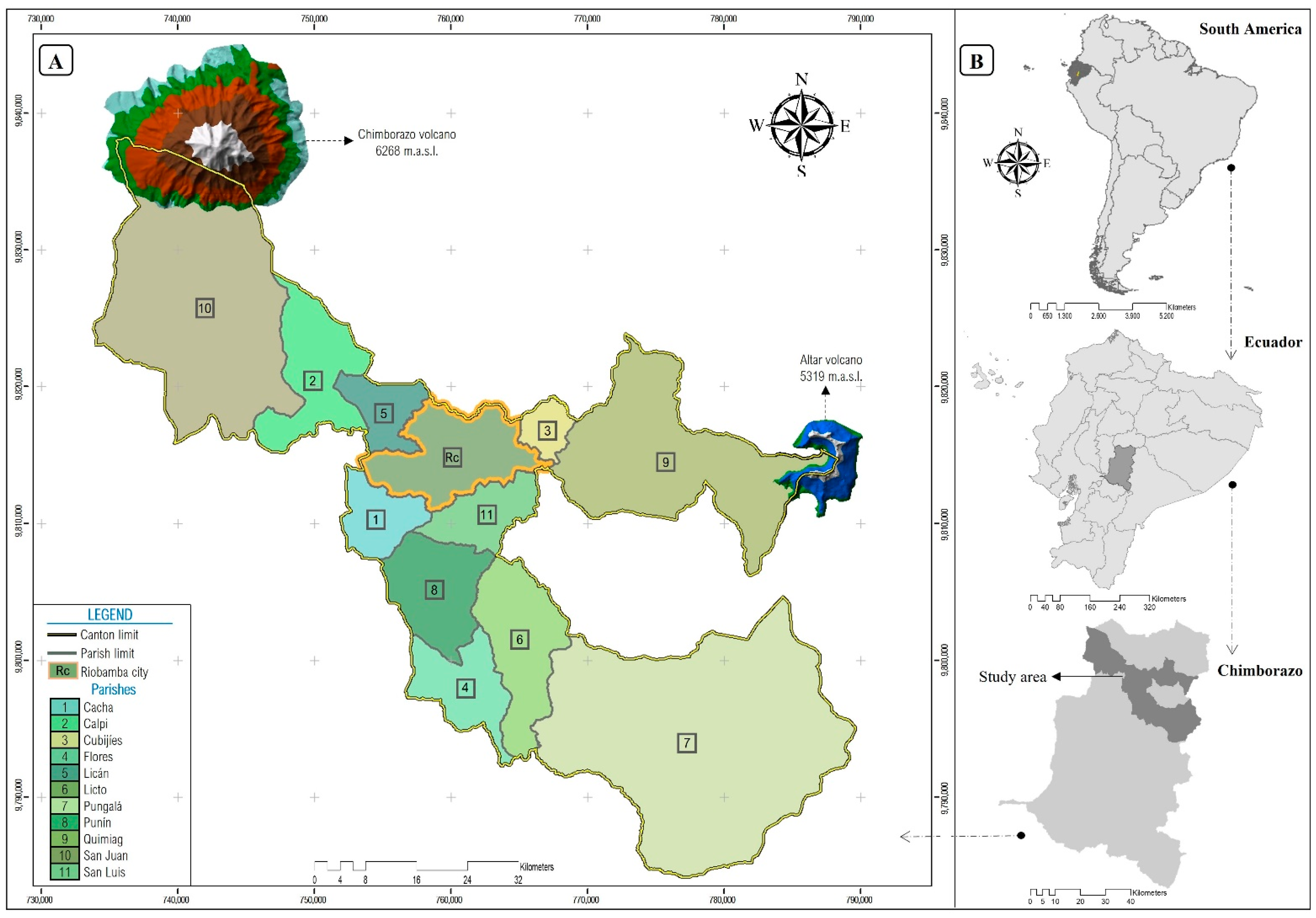
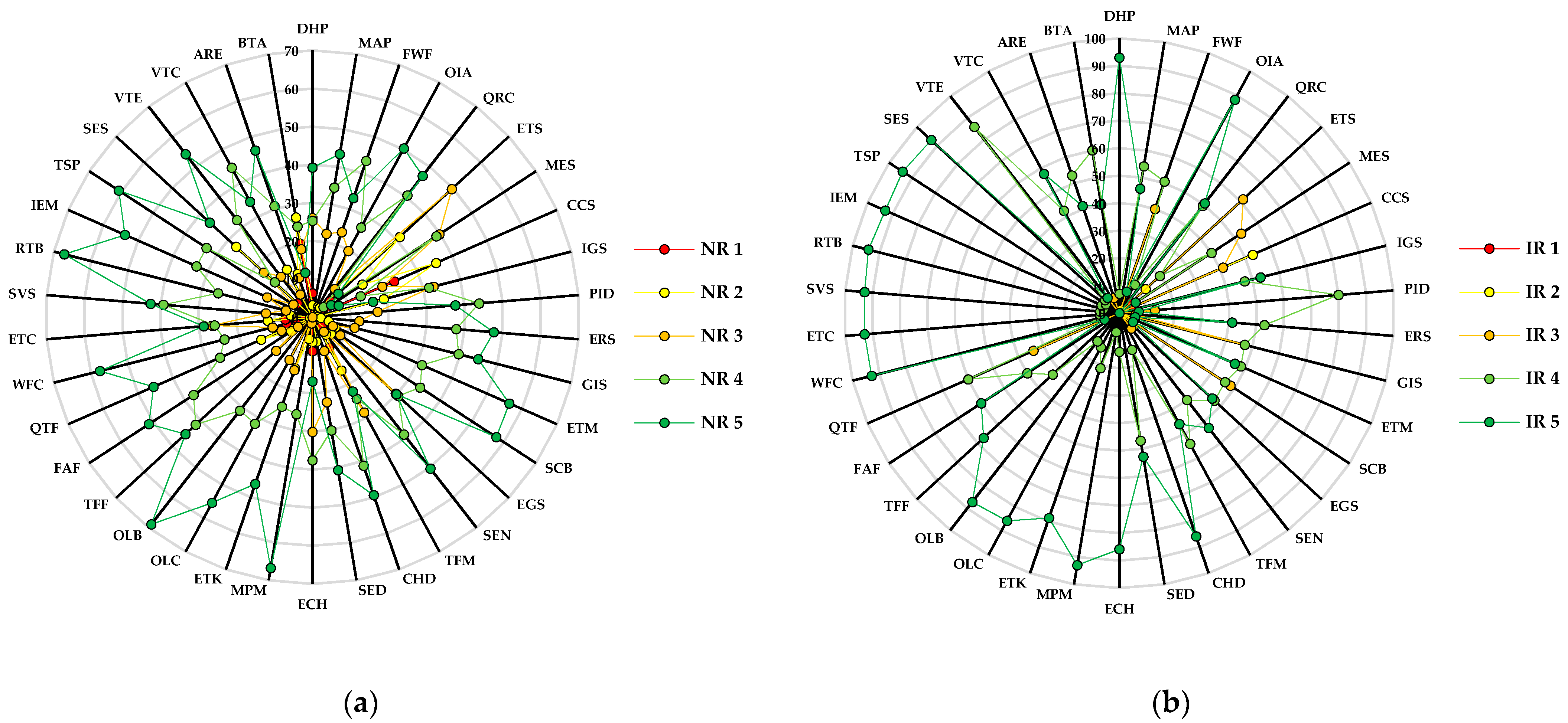
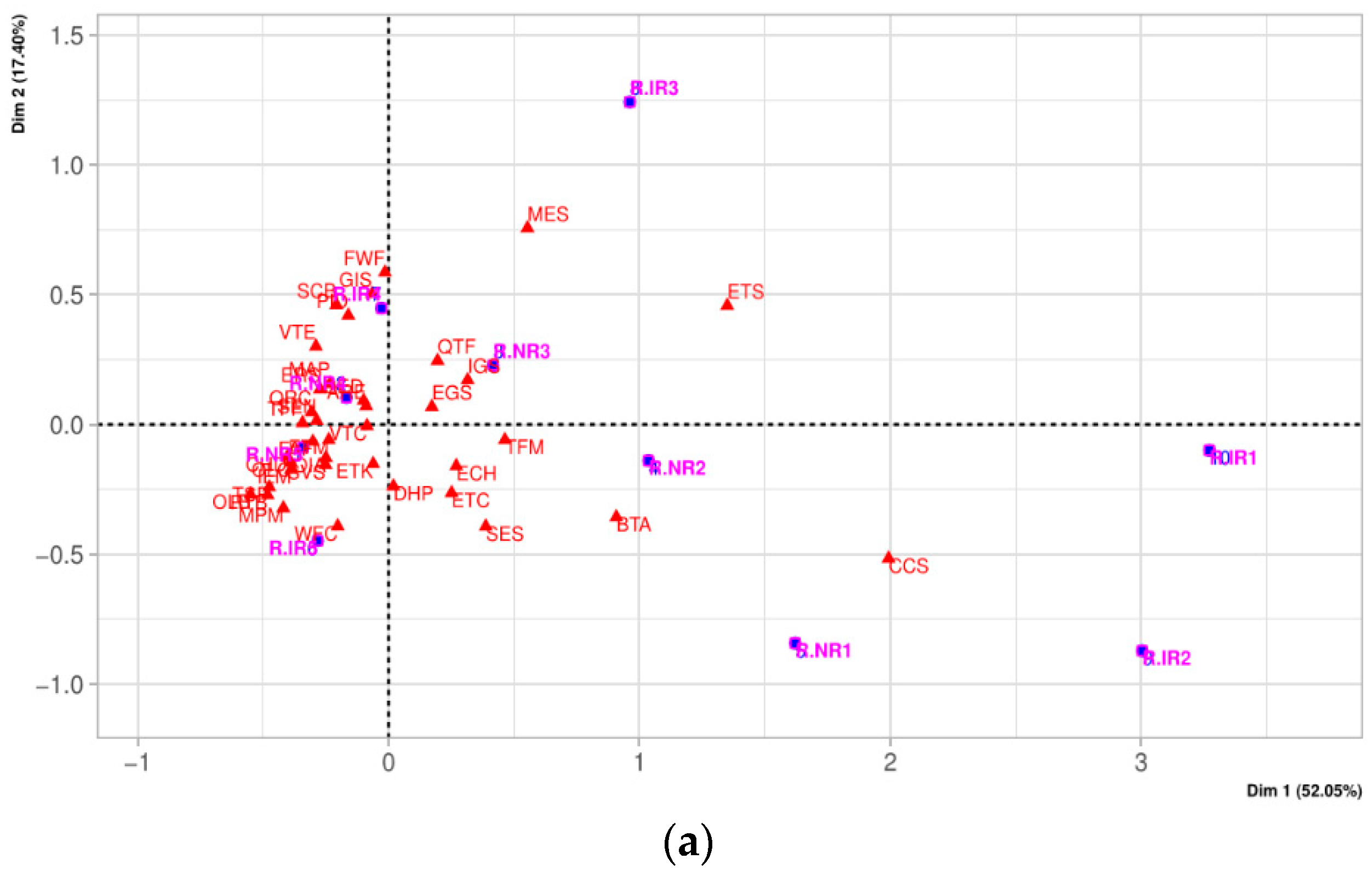

| Feature | Item | Total | |
|---|---|---|---|
| N | % | ||
| Gender | Male | 246 | 49.20 |
| Female | 254 | 50.80 | |
| Ethnic group | Afro-American | 9 | 1.80 |
| Caucasian | 42 | 8.40 | |
| Indigenous | 41 | 8.20 | |
| Metis | 408 | 81.60 | |
| Provenance | Local | 254 | 50.80 |
| National | 161 | 32.20 | |
| South American | 43 | 8.60 | |
| North American | 33 | 6.60 | |
| Other | 9 | 1.80 | |
| Age | ≤30 years old | 193 | 38.60 |
| 31–40 years old | 154 | 30.80 | |
| 41–50 years old | 97 | 19.40 | |
| 51–60 years old | 46 | 9.20 | |
| >60 years old | 10 | 2.00 | |
| Level of education | Primary | 2 | 0.40 |
| Secondary | 46 | 9.20 | |
| Highschool | 107 | 21.40 | |
| Bachelor or more | 345 | 69.00 | |
| Marital status | Single | 237 | 47.40 |
| Married | 194 | 38.80 | |
| Divorced | 34 | 6.80 | |
| Common law | 13 | 2.60 | |
| Widow (er) | 22 | 4.40 | |
| Level of monthly income | USD ≤ 400 | 170 | 34.00 |
| USD 401–1086 | 207 | 41.40 | |
| USD 1087–2172 | 90 | 18.00 | |
| USD 2172–3258 | 7 | 1.40 | |
| USD 3259–4344 | 6 | 1.20 | |
| USD > 4344 | 20 | 4.00 | |
| Analysis Level | Dimensions | Eigen Values | Explained Variance [%] | Cumulated Variance [%] |
|---|---|---|---|---|
| Tourist sample | Dimension 1 | 0.261 | 52.05 | 52.05 |
| Dimension 2 | 0.087 | 17.40 | 69.45 | |
| National tourists subsample | Dimension 1 | 0.257 | 68.49 | 68.49 |
| Dimension 2 | 0.066 | 17.55 | 86.04 | |
| International tourists subsample | Dimension 1 | 0.633 | 56.71 | 56.71 |
| Dimension 2 | 0.334 | 29.88 | 86.59 |
Publisher’s Note: MDPI stays neutral with regard to jurisdictional claims in published maps and institutional affiliations. |
© 2021 by the authors. Licensee MDPI, Basel, Switzerland. This article is an open access article distributed under the terms and conditions of the Creative Commons Attribution (CC BY) license (https://creativecommons.org/licenses/by/4.0/).
Share and Cite
Castillo Vizuete, D.D.; Gavilanes Montoya, A.V.; Muñoz Jácome, E.A.; Chávez Velásquez, C.R.; Borz, S.A. An Evaluation of the Importance of Smart Tourism Tools in the Riobamba Canton, Ecuador. Sustainability 2021, 13, 9436. https://doi.org/10.3390/su13169436
Castillo Vizuete DD, Gavilanes Montoya AV, Muñoz Jácome EA, Chávez Velásquez CR, Borz SA. An Evaluation of the Importance of Smart Tourism Tools in the Riobamba Canton, Ecuador. Sustainability. 2021; 13(16):9436. https://doi.org/10.3390/su13169436
Chicago/Turabian StyleCastillo Vizuete, Danny Daniel, Alex Vinicio Gavilanes Montoya, Eduardo Antonio Muñoz Jácome, Carlos Renato Chávez Velásquez, and Stelian Alexandru Borz. 2021. "An Evaluation of the Importance of Smart Tourism Tools in the Riobamba Canton, Ecuador" Sustainability 13, no. 16: 9436. https://doi.org/10.3390/su13169436
APA StyleCastillo Vizuete, D. D., Gavilanes Montoya, A. V., Muñoz Jácome, E. A., Chávez Velásquez, C. R., & Borz, S. A. (2021). An Evaluation of the Importance of Smart Tourism Tools in the Riobamba Canton, Ecuador. Sustainability, 13(16), 9436. https://doi.org/10.3390/su13169436









